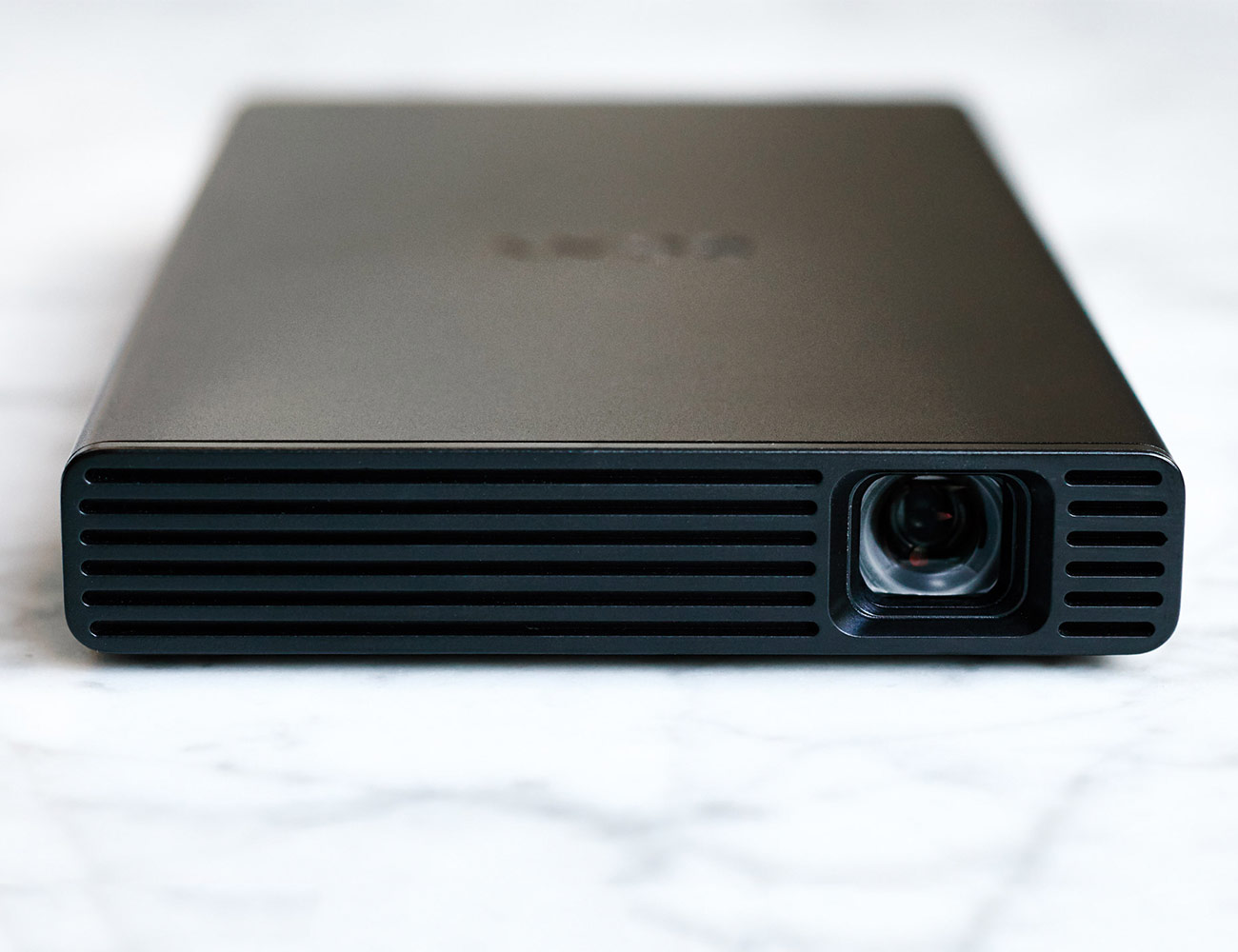Pico projectors are an admittedly niche category. After rising in popularity in 2015 and then experiencing a kind of lull in the years afterward, companies like Anker, Sony and LG are trying to make them cool again. Or rather, they’ve always been pretty cool, in my opinion, but pico projectors are now smaller, more versatile and able to produce better pictures these days. However, with smartphones and computers being so advanced and streaming devices being so readily available, a pico projector is a essential luxury gadget – it’s really only businessmen who want to projector presentations, frequent travelers who want to big a bigger viewing experience into their hotel rooms or simply lovers of niche tech who want to just like. Still, if those people are looking for a good pico projector, they’ve got a few choices.
Enter the Sony MP-CD1 ($369+). Released in 2018, it shares a similar look and design as the company’s 2015-released Sony MP-CL1A ($350) portable projector, but the main difference between the two is brightness. The MP-CD1 utilizes Texas Instruments’s DLP IntelliBright LED technology, enabling it to emit up to 105 lumens, in contrast to the MP-CL1A’s 32 lumens, meaning it’s much brighter. Additionally, the Sony MP-CD1 has an HDMI port for source connection, USB-A and USB-C ports for charging, and a 3.5mm jack, so you can easily to attach a separate speaker for improved audio.
The main competition for the MP-CD1 is the Anker Nebula Capsule. It’s completely different looking and is slightly cheaper than the MP-CD1, but its image quality – less than HD – is very similar. I reviewed the Nebula Capsule earlier this year and throughout this review, I compare the two pico projectors. Which should you buy?
| |
The Good: The Sony MP-CD1 looks sleeker and more stylish than many other portable projectors in this price range. It can almost fit in your pocket, as it’s only slightly bigger than the latest big-screen smartphones. It couldn’t be simpler to use – you just plug its HDMI (with an adapter) into your laptop, smartphone or gaming console and it projects the screen onto a wall. Its 5,000mAh battery is pretty decent, lasting for around 2.5 hours on a single charge. It can function as a portable power bank for your smartphone. And it charges via USB-C, so you can charge it with the same charger you use with your newer MacBook Pro or Android smartphone, or even your Nintendo Switch. The fan is quieter than other pico projectors.
Who They’re For: Like most portable projectors, the Sony MP-CD1 is best used as a travel gadget. It’s optimal for hooking up to a smartphone or laptop and blowing up videos or presentations on the big screen. The fact that it’s so slim, functions as a separate power bank and charges via USB-C, makes it a great addition for modern globetrotters or all-around gadget lovers.
Watch Out For: The Sony MP-CD1 might be extremely easy to use, but it lacks some pretty crucial features that other portable projectors have. There’s no wi-fi or built-in operating system to play content without a source. (The Nebula Capsule, comparatively, has an Android operating system so all you have to do is connect to wi-fi and you can stream content from Netflix, Hulu or YouTube.) There’s no Bluetooth either, so you can’t stream audio. There’s no remote. Its speakers are weak. There’s no volume dial, oddly, so you can’t adjust the volume on the projector. The picture is less than HD quality (which is about the same as other pico projectors) and the room needs to be really dark room for it to perform well.
Alternatives: The Anker Nebula Capsule is the obvious alternative. It’s a completely different form-factor, looking more like a soda can than a sleek portable projector, but it’s slightly cheaper and more versatile than the Sony MP-CD1. LG’s PH550 projector ($447+) is a larger and more expensive option, too.
Review: Portable mini projectors, or pico projectors, sky-rocketed in popularity in 2015. It’s been a few years, but the category and its technology seem to have finally caught up to 2018. They’re wireless. They’re small. And they can give you a screen way bigger than most people could fit in their homes. The problem is that with all the other gadgets in your bag – smartphone, laptop, power bank, gaming console – is there enough room for a pico projector? For most people, the answer is probably not. But for some, the answer is, maybe, yes.
For under $400, the Sony MP-CD1 is one of the most affordable pocketable projectors you can buy. Its main rival is the Anker Nebula Capsule ($348), which was also released earlier in 2018, but the two projectors couldn’t look or work any differently. Sony’s option is definitely sleeker and more packable, while the Anker option, with its built-in wifi and Android operating system.
Admittedly, the Sony MP-CD1 isn’t a standalone device like the Anker Nebula Capsule. In order to project anything on the Sony MP-CD1, you need to connect it (via HDMI) to something: your computer, laptop or gaming console. It’s really easy to do, and the projector comes with most of the necessary cables – some adapters need to be purchased separately – but this really is a projector and nothing else. The Anker Nebula Capsule, on the other hand, can run its own apps and stream its own content as long its connected to wi-fi.

I’ve tested and played around with quite a few of these portable mini projectors, and the Sony MP-CD1 is the brightest. None of their picture qualities will blow you away, however, as like many others the Sony MP-CD1 doesn’t come close to HD quality. If you’re thinking this little projector is going to replace your TV, then you probably don’t watch your TV very often. And like other pico projectors, the Sony MP-CD1 needs a dark environment to work well. If the room is at all bright, you’re probably going to be frustrated.
Two other things that I need to mention about the Sony MP-CD1. First, it’s a projector that you’re going to want to connect to a separate speaker – the built-in speakers on this thing simply aren’t very good. Fortunately, it’s super easy to daisy chain the projector to any speaker and instantly improve its audio. Secondly, there’s no built-in tripod so the only way to adjust the level of the screen is to stack it on top of something. A lot of these pico projectors suffer from this, but, again, it’s worth mentioning.
Verdict: There are a few things that the Sony MP-CD1 has going for it. It looks like a cool gadget. It’s extremely portable. It works as a separate portable power bank, too, and it charges via USB-C, which is great for anybody with a new-ish smartphone or laptop. It’s quiet, or at least quieter than other pico projectors so the fan won’t interfere with sound quality. Lastly, it’s super easy to use and its picture quality is on par with other similarly-priced pico projectors.
However, Sony MP-CD1 is not an all-in-one media player and it depends entirely on the other devices you have. This is a travel gadget, remember, not a home media system; and there won’t be many occasions (if any) where you’d want to use this thing instead of your TV. It’s ideal for businessmen who want to quickly throw something from their smartphone or laptop onto a big screen. Or if you have a streaming stick, like a Roku or Chromecast, you could plug it into this thing and it’ll work great. That said, $400 still seems like a lot for such a niche product and for that kind of money, you really want to make sure you’re going to use this thing a lot.
What Others Are Saying:
• “Crucially, it also has its own sound system, but don’t get excited. The chassis of the MP-CD1 itself is equipped only with a 1W speaker, which despite going to surprisingly loud volumes generally fails to deliver anything but vocals with any kind of width. Luckily, there’s a 3.5mm audio jack on the MP-CD1, so all audio can be routed to a separate wireless speaker. Place that speaker under the image and you’ve got a DIY home cinema.” — Jaime Carter, South China Morning Post
• “Image quality was middling and dull on the MP-CD1 at best. With only 105 lumens and a 400:1 contrast ratio, colorful pictures consistently felt dark and blown out. Blue colors looked more violet, and yellows took on a neon green appearance. And despite its manual focus option, the picture never felt very sharp. Images, however, consistently looked better than video throughout our testing. The projector is best for darkened rooms, rather than ones with ambient or full light.” — Suzanne Humphries, Top 10 Reviews
• “Setup is not as simple as it could be, and the lack of a volume rocker is bizarre, but the MP-CD1 produces reasonably impactful 80-inch still images and watchable movies. Does it do enough for the money? Probably not, but if you do give impromptu presentations and don’t want to depend on the quality of tech you find in offices and hotels, the MP-CD1 (preferably pimped-up with a small portable speaker and a wireless dongle) will do the job.” — Jamie Carter, TechRadar
Key specs
Screen size: up to 120-inches
Resolution: 854×480 pixels
Brightness: 105 Lumens
Battery: up to two hours
Ports: HDMI, USB-C (charge)
| |
Hot takes and in-depth reviews on noteworthy, relevant and interesting products. Read the Story





